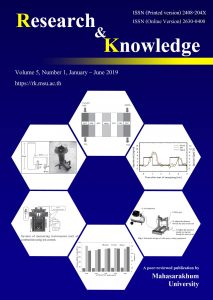Study to development of the passive direct ethanol fuel cell by mathematical model
Keywords:
alternative, ethanol, fuel cell, mathematical model, water crossover, performanceAbstract
Ethanol is the interested fuel because it is low toxic and has higher energy density and it can produce from biomass. Direct ethanol fuel cell (DEFC) is the alternative fuel cell that is the sustainable energy for the portable electronic device. Now it is not easy to control the level of energy because the oxidation and reduction reactions are very slow and the crossover of water and ethanol. So this research studies the performance of the direct ethanol fuel cell especially on the passive type DEFC and interests to study three mixtures of ethanol consist of ethanol mixed with tap water, ethanol mixed with drinking water and ethanol mixed with pure distilled water. Also study about the effect of fuel cell working temperature. From which the researcher conducted the experiment to analyze the optimization of the performance of the passive direct ethanol fuel cell for the portable electronic device. This research will predict a trend of electrical potential (DEFC cell voltage) when it is out of the condition of the experiment. By using a knowledge of engineering to make a mathematical model and fi nd out the suitable condition and compare with the results of experiment and predict a trend of electrical properly.
References
Abdullah, S., Kamarudin, S.K. (2015). Development of a conceptual design model of a direct ethanol fuel cell (DEFC), International Journal of Hydrogen Energy, vol. 40, pp. 11943-11948.
Andreadis, G., Podias A.K.M. and Tsiakaras, P. (2008). The effect of the parasitic current on the direct ethanol PEM fuel cell operation, Journal of Power Sources, vol. 181, pp. 214-227.
Andreadis, G., and Tsiakaras, P. (2006). Ethanol crossover and direct ethanol PEM fuel cell performance modeling and experimental validation, Chemical Engineering Science, vol. 61, pp. 7497- 7508.
Chu, Y.H., and Shul, Y.G. (2012). Alcohol crossover behavior in direct alcohol fuel cells (DAFCs) system, Fuel Cells, vol. 12, pp. 109-115.
Kamarudin, S.K., Achmad, F. and Daud, W.R.W. (2009). Overview on the application of direct methanol fuel cell (DMFC) for portable electronic devices, International Journal of Hydrogen Energy, vol. 34, pp. 6902-6916.
Larminie, J. and Dick, A. (2003). Fuel cell systems explained, John Wiley & Sons, West Sussex.
Matsuoka, K., Iriyama, Y., Abe, T., Matsuoka, M., and Oguni, Z. (2005). Alkaline direct alcohol fuel cells using an anion exchange membrane, Journal of Power Sources, vol. 150, pp. 27-31.
Nandenha, J. and Spinacé, E.V. (2014). The effect of ethanol concentration on the direct ethanol fuel cell performance and products distribution: a study using a single fuel cell attenuated total reflectance-Fourier transform infrared spectroscopy, Journal of Power Sources, vol. 253, pp. 392-396.
Roelofs, K.S., Hirth, T. and Schiestel T. (2011). Dihydrogenimidazole modified silica-sulfonated poly (ether ketone) hybrid materials as electrolyte membranes for direct ethanol fuel cells, Materials Science and Engineering: B, vol. 1767, pp. 27-35.
Saisirirat, P. (2018). The passive direct ethanol fuel cell performance investigation for applying with the portable electronic devices, IOSR Journal of Engineering, vol. 8, pp. 57-68.
Shimizu, T., Momma, T., Mohamedi, M., Osaka, T. and Sarangapani, S. (2004). Design and fabrication of pumpless small direct methanol fuel cells for portable applications, Journal of Power Sources, vol. 137, pp. 277-283.
Song, S.Q., Zhou, W.J. et al. (2005). Direct ethanol PEM fuel cells: the case of platinum based anodes, International Journal of Hydrogen Energy, vol. 368, pp. 995-1001.
Wongyao, N.,Therthianwong, A. and Therthianwong, S. (2011). Performance of direct alcohol fuel cells fed with mixed methanol/ethanol solutions, Energy Conversion and Management, vol. 5226, 2011, pp. 76-81.
Xu, Q., Zhao, T.S., Yang, W.W. and Chen, R. (2011). A flow field enabling operating direct methanol fuel cells with highly concentrated methanol, International Journal of Hydrogen Energy, vol. 368, pp. 30-80.
Downloads
Published
How to Cite
Issue
Section
License

This work is licensed under a Creative Commons Attribution-NoDerivatives 4.0 International License.








